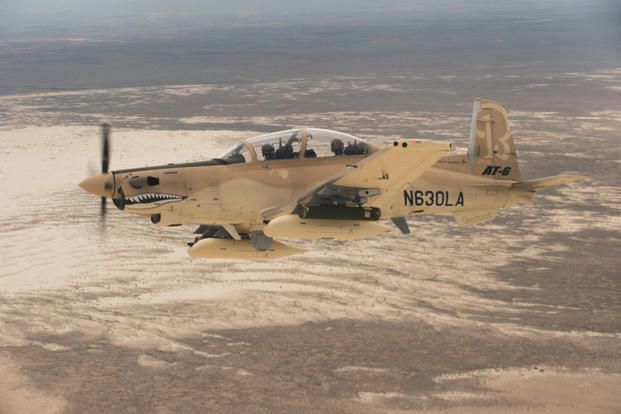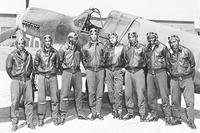The Senate Armed Services Committee has set aside millions for light attack aircraft, but this time not solely for the U.S. Air Force.
In its version of the fiscal 2019 budget markup, the committee announced last week it wants to give $100 million to the Marine Corps to procure light attack aircraft such as the AT-6 Wolverine to boost lower-cost aviation support. The version passed the committee with a vote of 25-2. It heads for a full Senate vote in coming weeks.
Is the Marine Corps ready for it? It's unclear.
“The Marine Corps continues to monitor the Air Force-led Light Attack Experiment to procure a cost-effective, observation and attack (OA-X) air platform for employment in permissive environments, with the intent to employ such an asset as a joint force capability,” said Capt Christopher Harrison of the Office of Marine Corps Communication at the Pentagon.
“The SASC's decision to authorize $100 million for a light attack platform is only reflected in a policy bill,” Harrison said in an email Friday.
“Nothing has been appropriated to this program yet,” he said.
But some experts say investing in light attack, though not the stealthiest or best equipped aircraft category, is not an entirely improbable idea.
Related content:
- Air Force Creates Office to Help It Shake Up Acquisition Process
- The Air Force's Light Attack Search Won't Yield a New A-10. Here's Why
- Congress Eager for Results of Air Force's Light Attack Aircraft Demo
"I'm not sure the Marines themselves saw the need for this, but light attack is very popular in Congress right now," said Richard Aboulafia, vice president and analyst at the Teal Group.
"I think there's a strong case for the Marines, or the Air Force, or both, having a few dozen light attack planes, if only for joint training and even combat missions with allied militaries in much poorer nations," Aboulafia told Military.com on Wednesday.
Lawmakers and a few Pentagon officials have made the case for light attack -- especially in the context of the Air Force's ongoing experiment with light attack platforms -- saying the smaller planes could come in handy to offset the cost to taxpayers to put a few fifth-generation fighters in the air, sometimes in support of missions for which the advanced jets are far overqualified.
For example, Air Force Secretary Heather Wilson this week reiterated it is silly to use a stealth fighter like the F-22 Raptor to take on Taliban drug labs. In November, the Raptor made its combat debut in Afghanistan, targeting suspected narcotics facilities in the country with small-diameter bombs.
"We should not be using an F-22 to destroy a narcotics factory," Wilson said, echoing previous statements she has made on the topic.
Light attack aircraft in that role would be more sensible, she said.
For the correct mission set, light attack makes sense for any service, Aboulafia argued. But purchasing an entire fleet, he said, would be unjustifiable, since the aircraft’s warfighting capabilities are significantly limited, and best suited to low-risk missions and training with allies and partners.
"The idea of buying hundreds of these planes is completely dysfunctional," he said.
"What kind of scenario would call for that? It postulates a giant failed state, or series of failed states, where the U.S. is compelled to intervene, and yet there's absolutely no air-to-air and only a minimal ground-to-air threat," Aboulafia said.
He added, "If there's either of those, this type of plane is a great way to kill pilots. And if this giant, under-armed failed-state intervention doesn't materialize, the military is stuck with hundreds of planes that have zero relevance to any other kind of strategic contingency."
While it seems the Marine Corps has time before it makes a decision on how it can or will proceed, the Air Force is currently in the middle of choosing a future light attack platform.
The Air Force selected two aircraft -- Textron Aviation AT-6 Wolverine and the Sierra Nevada/Embraer A-29 Super Tucano -- to undergo more demonstration fly-offs, among other exercises, at Holloman Air Force Base, New Mexico. The demonstrations began May 7 and will run through July, with the secretary herself expected to fly either or both aircraft at Holloman.
The Senate Armed Services Committee, in its fiscal 2019 proposal, added $350 million to procure a future light attack aircraft.
The A-29 -- used by the Afghan air force in its offensive against the Taliban -- is being pitted against the Wolverine, which is already used to train both Air Force and Navy student pilots.
During a phone call with reporters in recent weeks, an industry source said on background that an Air Force request for proposal is anticipated as early as October.
A contract award for a few hundred planes could be granted as quickly as six months after the RFP publication, he said.
-- Oriana Pawlyk can be reached at oriana.pawlyk@military.com. Follow her on Twitter at @Oriana0214.










